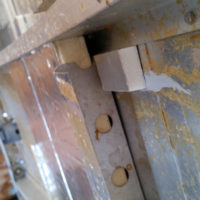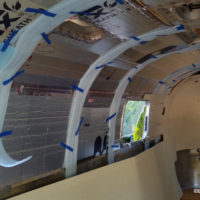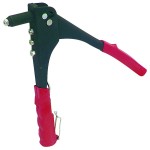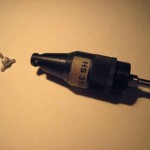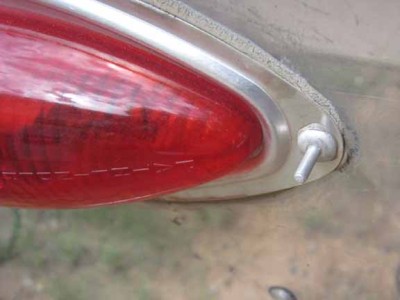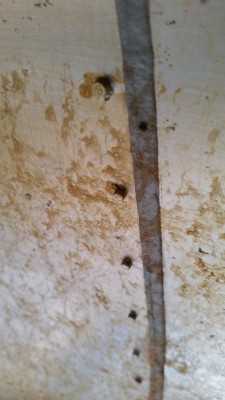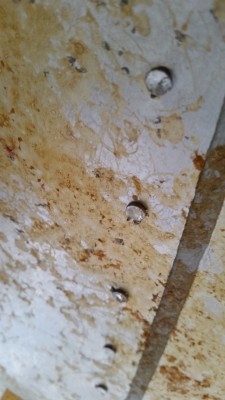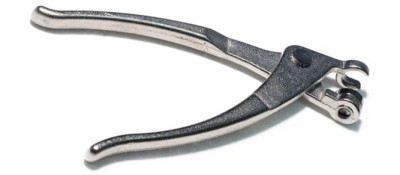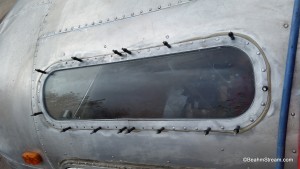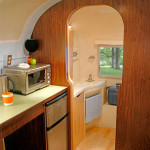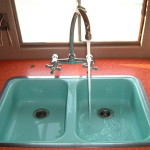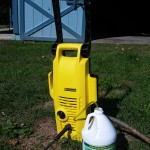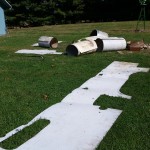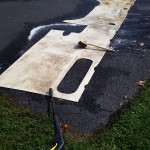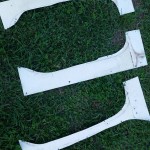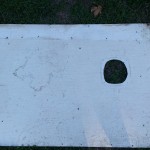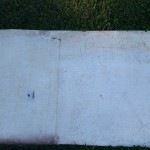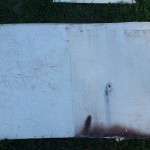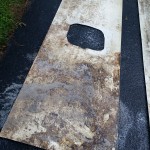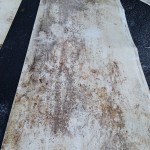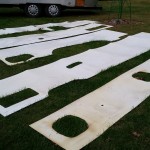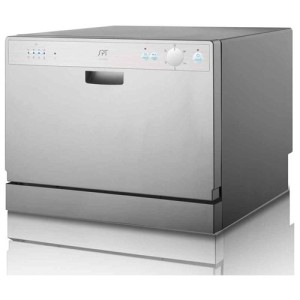Sprayed Foam vs. Rigid Panel vs. Batt vs. Bubble/Foam Foil
I had quite a few questions to answer before deciding how I would insulate our Airstream. I was lucky enough to get our trailer with the interior already removed, which means I didn’t have to deal with the toxic mess of removing the original fiberglass batt, which is almost ALWAYS infested with rodents, their homes and tunnels, and their droppings in these older Airstreams. Not only that, but the batt is usually wet and filled with mold, and often still glued to the skins and difficult to remove completely.
I knew I wouldn’t be reinstalling fiberglass (it’s AWFUL to work with, and doesn’t hold up as well as a lot of the newer alternatives), but I wasn’t certain as to which option would be best for us. My initial thoughts revolved around using Spray Foam, but I did a lot of research and eventually decided to go a different route.
Here were my areas of concern when thinking about insulation for the Airstream:
- maximizing R value
- containing heat while allowing vapor/moisture to escape (we plan on using our Airstream all four seasons)
- ease of installation
- cost
- availability
- durability and endurance (how long the insulation will last)
Spray Foam
As mentioned, Spray Foam was my initial choice for insulating the Airstream. The thought of using a very light product that not only gets into EVERY nook and cranny, but also seals things up and ads structural integrity to the trailer just seemed like a no brainer. However, there were some issues I uncovered that eventually caused me to go in another direction.
Spray Foam Cons (for my Airstream):
- Harder to find material or someone to do it
- Commercial sprayers create heat than can warp skins and ribs
- You have to do it all at once (nozzles are one time use, rented equipment or someone else doing it, etc.)
- Even though it’s not necessarily toxic (depending on the specific product), it makes a mess
- Once installed, repairs are very difficult because the foam is bonded to the skin and must be removed with chemicals –this is the main reason Timeless Travel Trailers doesn’t use spray foam in their trailers
A lot of people on the Airstream forums expressed concerns with Spray Foam breaking down into “fine powder” because of road vibration, but I think there are enough examples of places it has been used successfully (factory installed in various Argosy and other brand trailers, most modern refrigerated trucks, people who’ve done it themselves, etc.), to eradicate those concerns. Perhaps the cheap “canned foam” options from big box stores would break down, but I think commercial products will hold up to the rigors of the road.
Bear in mind, if you go the Spray Foam route, you need to make sure the product is closed-cell foam (not open cell, like the canned stuff at the big box stores, which will take on and retain moisture).
Also, spray foam seams like a bad idea for the chassis (insulating the underside), as it will retain water between the floor and the foam and thus contribute to floor rot, not to mention it prevents access to all the stuff down there that might need regular access (wiring, plumbing, holding tanks, etc.).
Fiberglass Batt or Rockwool
If the state of the original fiberglass or rockwool that you see when removing your panels isn’t enough to assure you that there are now better choices, here are some other reasons fiberglass batt sucks:
- collects and retains moisture that turns into mold
- moisture greatly reduces R value
- is easily penetrated (inviting even) and harbors vermin
- awful to work with (incredibly itchy in your skin)
- settles in the walls to reduce R values over time much more so than rigid panels or spray foam
Foil-faced Foam and/or Bubble Wrap
A lot of people go with Reflectix or Prodex. And though the two products look similar, they are actually quite different. Reflectix is foil-faced bubble wrap (yes, that bubble wrap). It’s fairly worthless. Prodex is actually foil faced closed-cell polyethylene foam, which has a greater R value than bubble wrap (meaning a “real” R value).
Reflectix is more readily available; you can pick it up at your local big box store, but it doesn’t do much for you. Your Airstream is already made of a reflective material (shiny aluminum!), and the bubble wrap doesn’t really insulate anything (very minimal air contained within the thin layer of “bubble”).
Prodex must be ordered, it’s relatively expensive, and I’ve read in quite a few places about Prodex delaminating (the layers coming apart). 700 square ft. (two, 24 inch wide x 175 ft. rolls) is around $250. Most variations on size still come in around $250 for 700 sq. ft., so the product is around $2.80/sq. ft. (right around the same price as Rigid PIC Panels).
Many people will point out Prodex’s claim of an R-16 rating, but that rating comes with some pretty unattainable parameters (at least in an Airstream). From their product spec sheet:
Parameters of test: 24-inch on center 2″ x 6″ wood assembly. Roof application. Test method ASTM 1116. Airspace of 2.64 inch on each side of product. Heat-flow direction down. Interior side of product exposed.
To get an R-16 rating from a 3/16″ sheet of Prodex, you need more than two-and-a-half inches of air space on either side of the material, PLUS air flow (venting). I can’t seem to find an R value for the product without the air space on either side.
Prodex is extremely easy to install and they claim it is self-sealing, so that’s great, but cost and availability (and the fact that the Airstream doesn’t have 5 inch walls) knocked it out of the running for me.
Polyisocyanurate Rigid Panels
There are several types of “rigid panel” foam products.
Polyisocyanurate (PIC) panels are rigid foam panels that are quite water resistant and sport an R value of 6.5 per one inch of thickness.
Thermasheath Rmax is sold in 4’x8′ sheets and is readily available at Home Depot (Lowe’s does not carry any PIC panels, only extruded poly and Styrofoam). At the time of this posting, here in Colorado a 1/2″ thick panel (R 3.2) is $11.97, a 1″ thick panel (R 6.5) is $16.35, and a 2″ thick (R 13.1) panel is $28.85. Obviously the 2″ thick product is too thick for the Airstream wall cavity, so you’ll either need to go with the 1″ thick product or multiple layers of the 1/2″.
The 1″ thick panels will need to be scored to follow the contour of the Airstream walls, and the scores then need to be resealed with foil tape to maintain the moisture/radiant barrier of the foil facing. The 1/2″ panels will actually bend enough to follow the contour of an Airstream (though not the compound curves of the end caps) without scoring the backside of the panel. If cost is not an issue (the half inch panels are more expensive in regard to total volume), multiple layers of 1/2″ panels are easiest to install since they don’t need to be scored. And in the grand scheme of things, the extra $8 per 1 inch thickness in a 4’x8′ panel is probably well-worth the extra cost in saved time and the fact that there are no voids from scoring and bending like the ones that will be created in the 1″ panels.
An added advantage of both rigid panels and foil faced flexible foam is you can run wires in the voids.
Other
FWIW, I’ve not heard of anyone using “blown-in” cellulose or recycled denim, but I would think potential moisture penetration would make that a bad choice, as well as major settling of the material from the motion and vibration of the trailer.
Thermal Bridge
Finally, something to consider is the thermal bridge… anywhere things “touch” from outside to inside will conduct heat/cold. Insulation can help mitigate this effect between exterior skin and interior skin, but the major problem area is the ribs, which touch both the exterior skin and interior skin, and are made from highly conductive aluminum!
I tried looking in to Aerogel/Thermagel for the Thermal Bridge. Specifically I e-mailed, called, and even snail-mailed Aspen Aerogels in Massachusetts, but I never received a response. I assume this is because I’m “small beans,” and they deal with only multi-million dollar outfits. Considering they seem to be marketing mostly to the oil industry, I am almost certain that Aerogel is cost prohibitive. I have a cousin in green tech and solar who let me know that Aerogel in it’s original form is pretty hard to work with. It was described to me as tapioca-like goo inside a thin wrapper. I would think punching a bunch of rivets through a bag full of pudding wouldn’t work so well.
I have wondered about using neoprene, some left over EPDM rubber I have from the roof on my studio, or even just the blue role of closed-cell poly material that you use between a house’s framing sill plate and the concrete foundation when building a house (i.e. something like Dow Weathermate Polystyrene which is readily available at Lowe’s/Home Depot). I’m not sure if such a thin layer of material would really help prevent heat transfer at the ribs. And even though it’s thin, I’m wondering if it would be a problem (an extra layer of material) between the ribs and skin.
On to part 2: practical application (what I actually did)…


















